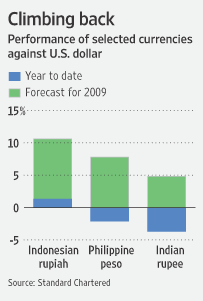This strategy, which involves borrowing in low-yielding currencies, and selling them in favor of higher-yielding ones (such as the Aussie) is making a comeback, as risk aversion ebbs and investors resume the search for yield. As Bloomberg News outlined in an excellent piece on the subject, “Stimulus plans and near-zero interest rates in developed economies are boosting investor confidence in emerging markets and commodity-rich nations with interest rates as much as 12.9 percentage points higher.” [ Chart Below courtesy of the WSJ.]
Technically, the change in investor sentiment has already been manifesting itself (in the form of higher asset prices) for a couple months. In reality, it wasn’t until Goldman Sachs published a report entitled “Time to Reconsider Carry” on April 8 that analysts began to specifically focus on the decline of risk aversion in forex markets. In the report, GS argued that “There are increasing signs that FX volatility has peaked” and “The conditions are about to fall in place to make carry strategies attractive again.”
The point is well-taken when you consider the paltry yields offered by the Euro, Dollar, and Yen, for example, combined with the fact that these currencies are now expensive, relative to a few years ago. “Borrowing U.S. dollars at the three-month London interbank offered rate of 1.13 percent and using the proceeds to buy real and earn Brazil’s three-month deposit rate of 10.51 percent rate would net an annualized 9.38 percent,” According to Bloomberg.
Investors could theoretically choose between any of these currencies, as well as the Swiss Franc, Canadian Dollar, and British Pound, all of which are backed by benchmark interest rates less than or equal to 1.25%. Ironically, the New Zealand and Australian Dollars- which could still be considered candidates for the long side of a carry trade - now feature interest rates well below those of the US and EU when they were at that their peak in 2008. This gives you an idea just how far rates have fallen since the inception of the credit crisis. It looks like the Yen has emerged as the favorite among the spectrum of funding currencies. The Yen makes a good choice because inflation and interest rates are extremely likely to remain close to zero for the foreseeable future.
The hard part is choosing which currency to go long.A summary of interest rates for actively-traded currencies reveals several yielding more than 10%. “Goldman Sachs recommended on April 3 that investors…buy Mexican pesos, real, rupiah, rand and rubles from Russia.” Bloomberg meanwhile pointed out that “An equally weighted basket of currencies consisting of Turkish lira, Brazilian real, Hungarian forint, Indonesian rupiah, South African rand and Australian and New Zealand dollars — bought with yen, dollars and euros — earned an annualized 196 percent from March 2 to April 10.” Standard Chartered Bank meanwhile, recommends the Indonesian rupiah, the Indian rupee and the Philippine peso. Investors not wanting to trade forex directly can buy the iPath Optimized Carry Trade Fund(ICI), an ETN which trades on the NYSE Arca exchange.
During the run-up in asset prices that preceded the current downturn, investors could count on stability, maybe even appreciation in riskier currencies that constituted the long end of their trades. This time around, such an assumption is not wise. One analyst warns investors not to be “caught short in the unwind".
Risks also need to be evaluated specifically to the currencies on the short and long ends of the trade. In analyzing the worth of the Brazilian Real as a long currency, one analyst notes that, “Lower commodity prices, a sudden dive back to safe haven currencies and fluctuation in inflation numbers all have the potential to squeeze the spread on carrying the real.” On the flip side, there is a risk that rates will increase for the funding currencies, although probably not for at least the next 12 month, if not longer.

0 comments:
Post a Comment